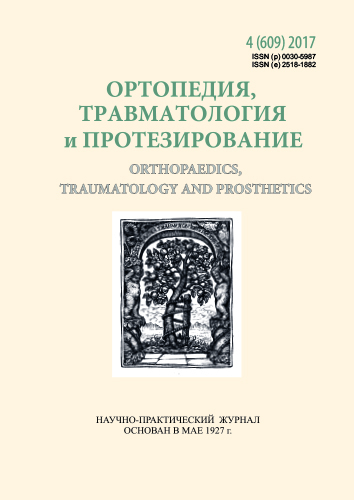Clinical-experimental correlation of residual spinal deformation development under the condition of thoracolumbar fractures
DOI:
https://doi.org/10.15674/0030-59872017449-56Keywords:
burst spinal fractures, residual deformation of spine, residual fixation of fragments, thoracolumbar spineAbstract
Objective: determination of residual deformation and fixation of the spine in thoracolumbar burst fractures.
Methods: the results of X-ray and CT examinations of 49 patients were analyzed, which were divided into 4 groups depending on the magnitude of kyphotic deformation: I (16 people) — from 0º to 12º, II (21) —from 12º to 21º, III (7) — from 21º up to 30º, IV (5) — more than 30º. In the experiment, 6 physical models were created: 1st — normal; 2nd — up to 50 % of the vertebral body and one adjacent intervertebral disc were destroyed; 3rd — 50 % of vertebral body destroyed, one adjacent intervertebral disc, posterior parts of vertebral body and roots of arches (incomplete with type A explosive fracture); 4th — 50 % of vertebral body, one adjacent intervertebral disc, posterior parts of vertebral body, pedicles, interspinous ligaments (type AB, AC); 5th — the whole body (100 %) and two adjacent discs (full burst fracture type A); 6th — 100 % of the vertebral body, discs, pedicles and ligaments (damages of the AC type).
Results: it is established that the parameters of the experimental models can be compared with the clinical data. The possibility of subsequent development of the spinal deformation is associated with the morphology of the injury. With the help of the developed experimental model, the main regularities of development of kyphotic deformation in thoracolumbar burst fractures were determined. It is shown that the destruction of the vertebral body to 50 % results into the development of primary deformation, which does not progress with further loading. Damage to the posterior support of the spinal column leads to the progression of residual deformation to 10 %.
Conclusions: the deformation of the spine occurs during the destruction of the vertebral body, immediately at the time of injury and depends on its intensity. In case of damage to the posterior parts of the spine, in the case of subsequent loading, the deformation progression is possible.
References
- Cahueque M, Cobar A, Zuñiga C, Caldera G. Management of burst fractures in the thoracolumbar spine. J Orthop. 2016;13(4):278–81. doi: 10.1016/ j.jor.2016.06.007.
- Bensch FV, Koivikko MP, Kiuru MJ, Koskinen SK. The incidence and distribution of burst fractures. Emerg Radiol. 2006;12(3):124–9. doi: 10.1007/ s0010140-005-0457-5.
- Bakhsheshian J, Dahdaleh NS, Fakurnejad S, Scheer JK, Smith ZA. Evidence-based management of traumatic thoracolumbar burst fractures: a systematic review of non operative management. Neurosurg Focus. 2014;37(1):E1. doi: 10.3171/2014.4.FOCUS14159.
- Berezovsky VА, Kolotilov NN. Biophysical descriptions of fabrics of man: reference Book. Кyiv: Naukova dumka. 1990, 224 p. (in Russian)
- Obrazcov IF, Adamovich IS, Barer OS, et al. Problems of durability in biomechanics. M:Vishay school. 1988, 312 p. (in Russian)
- Busscher I, Ploegmakers JJ, Verkerke GJ, Veldhuizen AG. Comparative anatomical dimensions of the complete human and porcine spine. Eur Spine J. 2010;19(7):1104–14. doi: 10.1007/s00586-010-1326-9.
- Aebi M, Arlet V, Webb J. AO spine manual principles and techniques: Vol. 1. Thieme, 2007. 663 р.
- Aebi M, Arlet V, Webb J. AO spine manual principles and techniques: Vol. 2. Thieme, 2007. 837 р.
- McCormack T, Karaikovic E, Gaines RW. The load sharing classification of spine fractures. Spine. 1994;19(15):1741–4.
- Magerl F, Aebi M, Gertzbein SD, Harms J, Nazarian S.. A comprehensive classificationof thoracic and lumbar injuries. Eur Spine J. 1994;3:184–201.
Downloads
How to Cite
Issue
Section
License
Copyright (c) 2018 Konstantin Popsuishapka, Mykhaylo Karpinsky, Andrey Popov, Igor Subota, Sergii Teslenko

This work is licensed under a Creative Commons Attribution 4.0 International License.
The authors retain the right of authorship of their manuscript and pass the journal the right of the first publication of this article, which automatically become available from the date of publication under the terms of Creative Commons Attribution License, which allows others to freely distribute the published manuscript with mandatory linking to authors of the original research and the first publication of this one in this journal.
Authors have the right to enter into a separate supplemental agreement on the additional non-exclusive distribution of manuscript in the form in which it was published by the journal (i.e. to put work in electronic storage of an institution or publish as a part of the book) while maintaining the reference to the first publication of the manuscript in this journal.
The editorial policy of the journal allows authors and encourages manuscript accommodation online (i.e. in storage of an institution or on the personal websites) as before submission of the manuscript to the editorial office, and during its editorial processing because it contributes to productive scientific discussion and positively affects the efficiency and dynamics of the published manuscript citation (see The Effect of Open Access).














